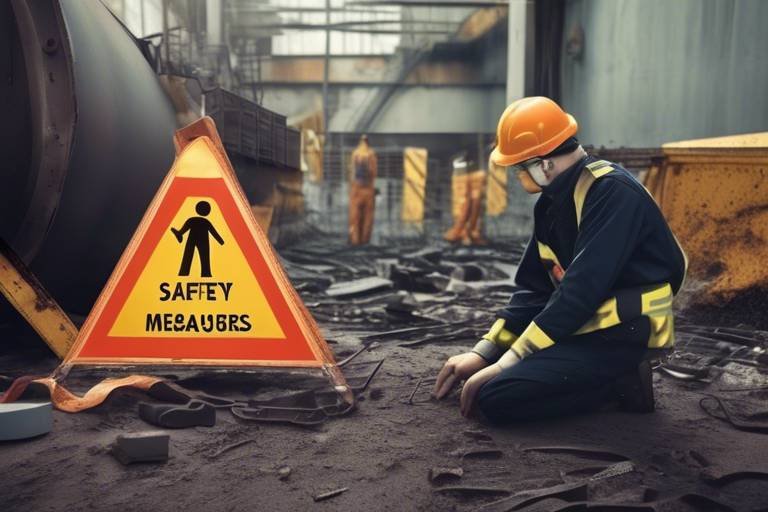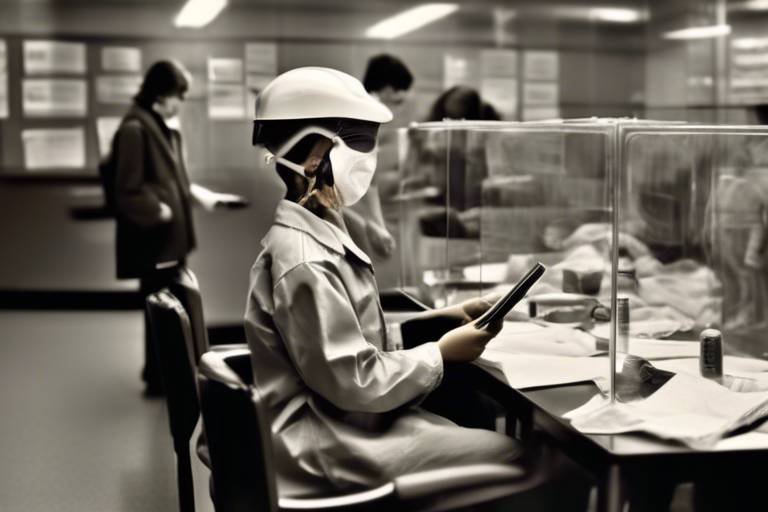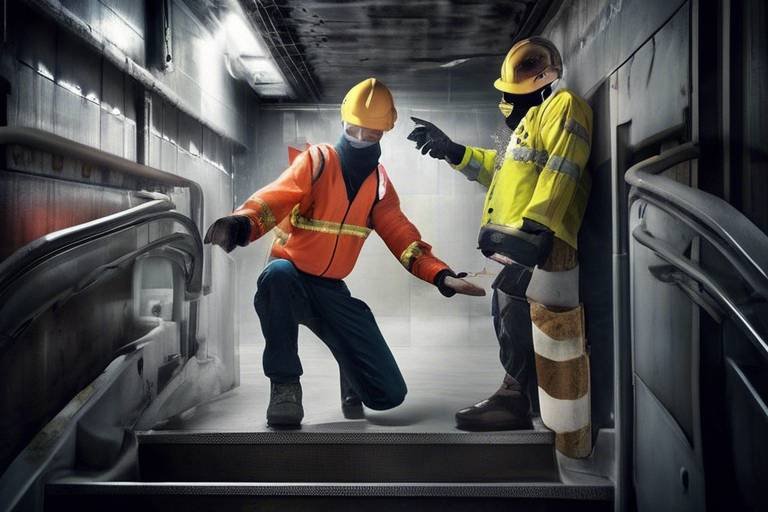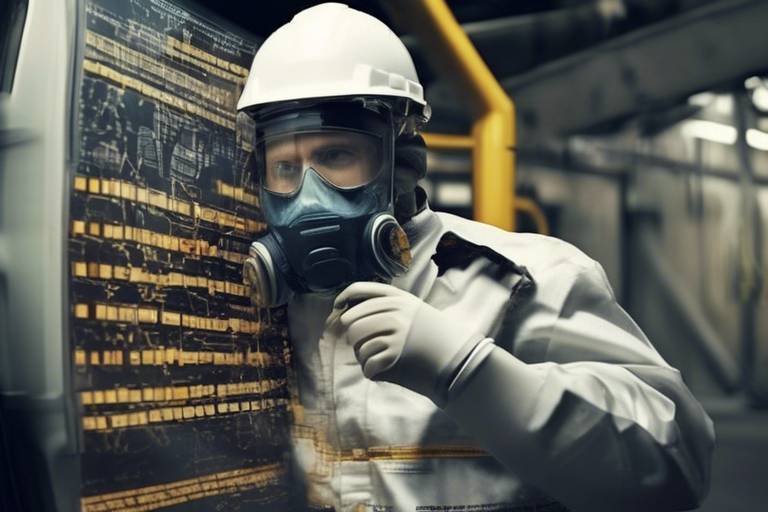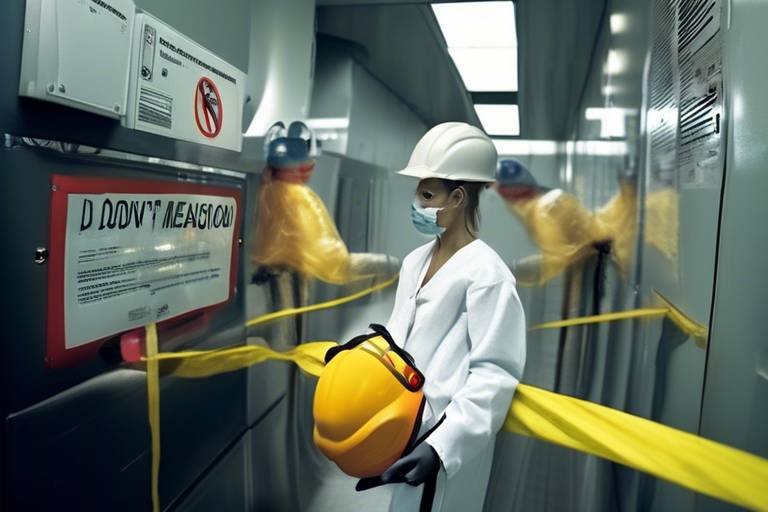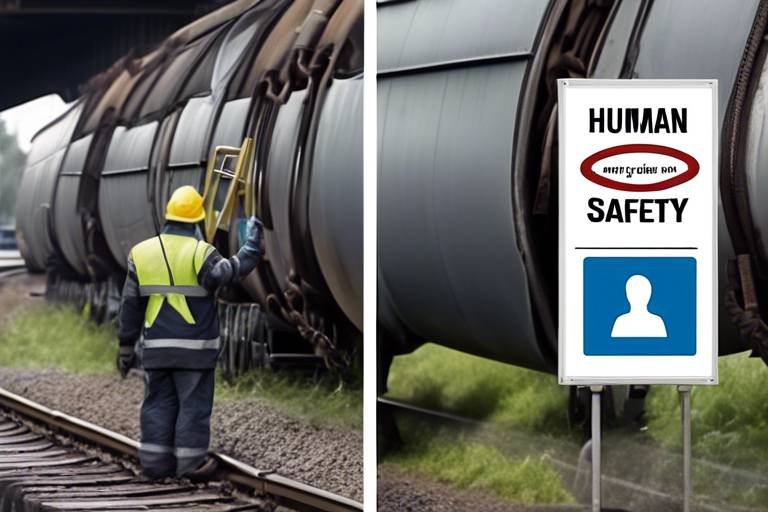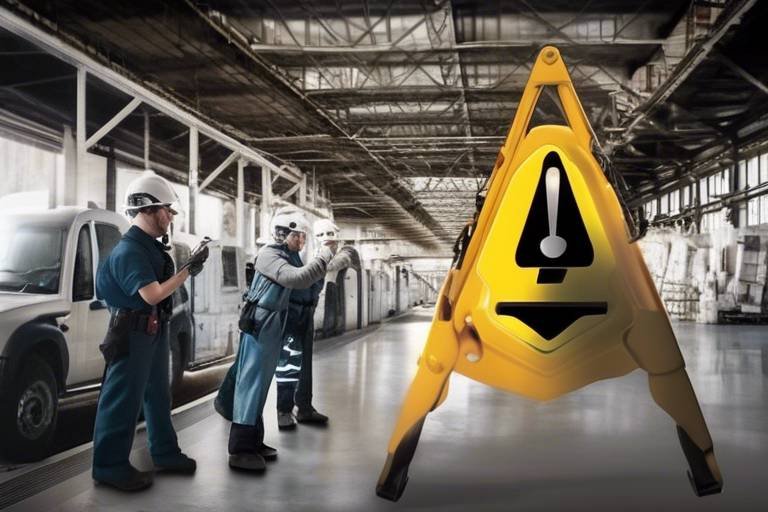How Understanding Human Behavior can Transform Safety Measures
In today's world, safety is more than just a set of rules and regulations; it's a complex interplay of human behavior, environmental factors, and psychological influences. Understanding the intricacies of human behavior can significantly enhance safety measures across various settings, from workplaces to public spaces. By diving deep into the motivations, perceptions, and actions of individuals, we can develop strategies that not only mitigate risks but also foster a culture of safety that resonates with everyone involved. Imagine a workplace where safety isn't just a compliance checkbox but a shared value that everyone actively participates in. That’s the power of understanding human behavior!
Think about it: every time someone makes a decision, they're influenced by a myriad of factors, including their past experiences, social dynamics, and even their emotional state at that moment. This is particularly true in high-stakes environments where the margin for error is slim. By analyzing how people perceive risks and make choices, organizations can tailor their safety protocols to align better with human tendencies. This means not only creating rules but also understanding the psychology behind compliance. By doing so, we can ensure that safety measures are not only effective but also embraced by those they are designed to protect.
The relationship between human behavior and safety measures is akin to a dance: it requires coordination, understanding, and adaptability. Just as a dancer must be attuned to their partner's movements, safety protocols must be responsive to the behaviors and perceptions of individuals. By fostering an environment where safety is prioritized and understood at every level, organizations can transform their safety culture into one that is proactive rather than reactive. This shift not only enhances safety outcomes but also builds trust among employees and stakeholders, creating a community that values each member's well-being.
In the following sections, we will explore various psychological factors that influence risk perception, the impact of cognitive biases on safety decisions, and the vital role of social dynamics in shaping safety behavior. Additionally, we will discuss how to cultivate a robust safety culture through effective communication and training, ensuring that safety becomes an integral part of organizational identity. So, buckle up as we embark on this enlightening journey to uncover how understanding human behavior can revolutionize safety measures!
- What is the importance of understanding human behavior in safety measures?
Understanding human behavior helps tailor safety protocols to align with how people think and act, leading to better compliance and reduced risks. - How can cognitive biases affect safety decisions?
Cognitive biases can lead to poor risk assessment and decision-making, which may compromise safety. Recognizing these biases is crucial for improving safety protocols. - What role do social influences play in safety behavior?
Social dynamics, such as peer pressure and group norms, can significantly impact individual safety behaviors, either positively or negatively. - How can organizations develop a safety culture?
A safety culture can be developed by fostering open communication, providing ongoing training, and encouraging shared responsibility for safety among all members.

The Psychology of Risk Perception
This article explores the intricate relationship between human behavior and safety measures, emphasizing how insights into behavioral patterns can lead to more effective strategies for enhancing safety across various environments.
Understanding how individuals perceive risk is crucial for developing effective safety measures. The way we perceive risk can often be skewed by various psychological factors, leading to decisions that may not align with reality. For instance, many people tend to overestimate the likelihood of dramatic events, such as plane crashes, while underestimating the risks associated with everyday activities like driving. This discrepancy in risk assessment can be attributed to several factors, including personal experiences, media portrayal, and inherent cognitive biases.
One of the key elements influencing risk perception is the availability heuristic. This mental shortcut leads individuals to judge the probability of an event based on how easily examples come to mind. For example, if someone frequently hears about shark attacks in the news, they may perceive swimming in the ocean as significantly more dangerous than it actually is. This highlights the importance of accurate information dissemination in shaping public perceptions of risk.
Moreover, emotions play a significant role in risk perception. Fear, for instance, can amplify the perception of risk, causing individuals to react more strongly to potential dangers. This emotional response can lead to irrational decision-making, where the fear of a low-probability event overshadows the actual risks present in more common situations. Understanding these emotional triggers is essential for developing safety measures that resonate with individuals on a deeper level.
To illustrate the complexities of risk perception, consider the following table that outlines various factors affecting how we perceive risk:
| Factor | Description |
|---|---|
| Personal Experience | Individual encounters with risk shape perception significantly. |
| Media Influence | How events are portrayed in the media can skew public perception. |
| Emotional Response | Fear and anxiety can distort rational risk assessment. |
| Cultural Context | Cultural beliefs and values can influence risk perception. |
Additionally, it's important to recognize that group dynamics can also influence individual risk perception. When individuals are part of a group, they may conform to the group's beliefs about risk, even if those beliefs are irrational. This phenomenon, known as groupthink, can lead to collective decisions that overlook significant safety concerns. Therefore, fostering an environment where open discussions about risk can occur is essential for effective safety management.
In summary, the psychology of risk perception is a complex interplay of cognitive biases, emotional responses, and social influences. By understanding these elements, we can develop safety measures that are not only effective but also resonate with the individuals they are designed to protect. This understanding paves the way for a more informed approach to safety, where decisions are based on a realistic assessment of risk rather than distorted perceptions.
Cognitive biases can significantly impact safety-related decisions. This subsection examines common biases that affect judgment and how recognizing them can improve safety protocols and training.
Heuristics are mental shortcuts that can lead to errors in risk evaluation. This section discusses how these shortcuts affect safety decisions and potential strategies to mitigate their impact.
Overconfidence can lead individuals to underestimate risks. This part explores the implications of overconfidence in safety contexts and ways to counteract this bias through education and awareness.
The anchoring effect can distort risk assessments based on initial information. Here, we investigate how this cognitive bias influences safety judgments and what can be done to address it.
Social dynamics play a vital role in shaping safety behaviors. This section focuses on how peer pressure and group norms can either enhance or undermine safety practices.
Creating a robust safety culture is essential for effective safety measures. This part outlines the key components of a safety culture and how understanding behavior can foster a proactive safety environment.
Effective communication is critical in promoting safety. This subsection discusses how tailored messaging can influence behavior and enhance compliance with safety protocols.
Ongoing training and education are vital for reinforcing safe behaviors. Here, we explore how understanding human behavior can inform the design of training programs that resonate with individuals and promote lasting change.
- What is risk perception? Risk perception refers to the subjective judgment people make about the characteristics and severity of a risk.
- How do cognitive biases affect safety decisions? Cognitive biases can lead to misjudgments about risks, causing individuals to underestimate or overestimate dangers.
- Why is understanding human behavior important for safety? Understanding human behavior helps in designing effective safety measures that resonate with individuals, leading to better compliance and risk management.
- What role does communication play in safety culture? Effective communication ensures that safety messages are understood and can influence behavior positively.

Understanding cognitive biases is like peering into the mind's maze, where shortcuts can lead to dangerous dead ends, especially when it comes to safety decisions. Cognitive biases are those pesky mental shortcuts that can skew our judgment, often leading us to make decisions that are less than ideal. Imagine you're driving and you see a stop sign, but your mind is racing, and you convince yourself that you can just roll through it. That’s a classic example of how our brains can mislead us!
In safety contexts, these biases can have serious implications. For instance, consider the availability heuristic, where people tend to think that something is more likely to occur if they can easily recall an example. If someone recently heard about a workplace accident, they might overestimate the likelihood of it happening again, leading to unnecessary panic or overreaction. Conversely, if they have never experienced an accident, they might underestimate the risks involved, thinking, “It won’t happen to me.” This inconsistency in risk perception can create a false sense of security or unwarranted fear.
Another common bias is the confirmation bias, where individuals seek out information that confirms their pre-existing beliefs while ignoring contradictory evidence. In safety decision-making, this can manifest in a way that endangers not only the individual but also their colleagues. For example, a worker might believe that a certain safety procedure is unnecessary because they’ve never had an incident, thus ignoring data that suggests otherwise.
To illustrate these biases further, let’s take a look at a simple table that summarizes some key cognitive biases and their potential effects on safety decisions:
| Cognitive Bias | Description | Potential Impact on Safety |
|---|---|---|
| Availability Heuristic | Overestimating the likelihood of events based on recent or vivid examples. | May lead to unnecessary panic or complacency. |
| Confirmation Bias | Favoring information that confirms existing beliefs while disregarding contradictory evidence. | Can result in ignoring safety protocols or data. |
| Overconfidence Bias | Believing one is less likely to experience a negative event compared to others. | May lead to risky behavior and negligence. |
| Anchoring Effect | Relying too heavily on the first piece of information encountered. | Can distort risk assessment and lead to poor safety judgments. |
Recognizing these biases is the first step toward mitigating their impact. By understanding how our minds work, we can develop strategies to counteract these biases. For example, implementing regular safety training that includes discussions about cognitive biases can help individuals become more aware of their own thought processes. Additionally, fostering an environment where questioning and critical thinking are encouraged can make a significant difference.
Ultimately, creating a culture that acknowledges these cognitive biases can lead to better safety decisions and practices. It’s about turning that awareness into action. So, next time you’re faced with a safety decision, take a moment to reflect: Am I falling prey to any of these biases? By asking ourselves this question, we can begin to make more informed and safer choices.
- What are cognitive biases? Cognitive biases are systematic patterns of deviation from norm or rationality in judgment, often leading to illogical conclusions.
- How do cognitive biases affect safety decisions? They can distort our perception of risk, leading to poor decision-making and potentially dangerous situations.
- Can cognitive biases be mitigated? Yes, through education, awareness, and fostering an environment that encourages critical thinking.
- What is the availability heuristic? It's a mental shortcut that relies on immediate examples that come to a person's mind when evaluating a specific topic or decision.

Heuristics are those nifty little mental shortcuts that our brains love to take when faced with complex decisions. Imagine you're at a buffet, trying to decide between a rich chocolate cake and a light fruit salad. Instead of weighing the pros and cons of each dessert, you might just grab the cake because it looks more appealing at first glance. This kind of thinking can be a double-edged sword, especially when it comes to safety decisions. While heuristics can help us make quick judgments, they can also lead us astray, particularly in high-stakes situations where safety is on the line.
In safety contexts, heuristics can manifest in various ways. For instance, when assessing risk, individuals often rely on their past experiences or the most readily available information instead of conducting a thorough analysis. This reliance can result in significant oversights. For example, if a worker has previously encountered a minor issue with machinery, they might underestimate the potential dangers during subsequent operations, thinking, "It won't happen again." This is where understanding heuristics becomes essential; it allows safety professionals to identify where individuals are likely to err and develop strategies to counteract these tendencies.
To illustrate the impact of heuristics on safety decisions, consider the following common types:
- Availability Heuristic: This occurs when individuals assess the probability of an event based on how easily they can recall similar instances. If a worker remembers a recent accident, they might overestimate the likelihood of it happening again, leading to unnecessary anxiety or over-caution.
- Representativeness Heuristic: This is when people judge the probability of an event based on how similar it is to a prototype. For instance, if a safety officer sees a particular type of equipment fail, they might assume all similar equipment is prone to failure, even if that isn't statistically justified.
So, how can we mitigate the effects of these heuristics in safety decisions? One effective strategy is to incorporate structured decision-making processes that encourage individuals to evaluate risks systematically rather than relying solely on instinct. By promoting a culture of critical thinking and evidence-based decision-making, organizations can help their employees make more informed choices, ultimately enhancing safety outcomes.
Training programs can also play a pivotal role in addressing the influence of heuristics. For example, simulations that expose workers to various risk scenarios can help them recognize their cognitive biases in real time. This hands-on approach not only makes the learning process engaging but also reinforces the idea that safety is not just about following rules; it's about understanding the reasoning behind those rules. By fostering an environment where questioning and critical thinking are encouraged, we can cultivate a workforce that is more adept at navigating the complexities of safety.
In summary, while heuristics can simplify decision-making, they can also cloud our judgment, especially in safety-critical situations. By being aware of these mental shortcuts and implementing strategies to counteract their effects, we can create a safer, more informed workplace. Remember, it's not just about being quick; it's about being smart in our safety practices.
- What are heuristics? Heuristics are mental shortcuts that simplify decision-making but can lead to errors in judgment.
- How do heuristics affect safety decisions? They can cause individuals to overlook risks or make assumptions based on past experiences rather than current data.
- What can organizations do to mitigate the effects of heuristics? Implement structured decision-making processes and provide training that encourages critical thinking and awareness of cognitive biases.

Overconfidence bias is a fascinating phenomenon that can have serious implications for safety in various contexts. Imagine you're driving a car, and you think, "I’m an excellent driver; nothing bad will happen to me." This inflated sense of self-assurance can lead to risky behaviors, such as speeding or texting while driving, ultimately increasing the likelihood of accidents. Overconfidence bias is essentially the tendency to overestimate one’s abilities, knowledge, or control over outcomes. In safety contexts, this bias can manifest in numerous ways, often resulting in dire consequences.
One of the most troubling aspects of overconfidence bias is that it can create a false sense of security. Individuals may ignore safety protocols or underestimate the risks associated with certain behaviors because they believe they are invincible. This is especially common in high-risk occupations, where workers might feel that their experience makes them immune to accidents. For example, a seasoned construction worker might skip wearing a hard hat, convinced that their years of expertise make them less susceptible to injury. This mindset can lead to a culture of complacency, where safety measures are viewed as unnecessary inconveniences rather than vital safeguards.
To combat overconfidence bias, organizations can implement several strategies:
- Education and Training: Providing ongoing training that emphasizes the importance of safety protocols can help individuals recognize their limitations and the potential dangers of their overconfidence.
- Encouraging Self-Reflection: Promoting a culture of self-assessment can encourage individuals to critically evaluate their skills and understanding of risks. Regular feedback sessions can help highlight areas where overconfidence might be leading to unsafe decisions.
- Using Data and Statistics: Presenting factual data about accidents and injuries can serve as a wake-up call for those who might be overestimating their abilities. For instance, showing statistics on how often experienced workers get injured can help ground their perceptions in reality.
Moreover, it’s essential to foster an environment where employees feel comfortable voicing their concerns without fear of judgment. When individuals can openly discuss their doubts and acknowledge their vulnerabilities, it can significantly reduce the impact of overconfidence bias. Encouraging teamwork and collaboration can also help, as peers can provide valuable insights and reminders about safety that might not be apparent to someone who is overly confident.
In conclusion, while overconfidence bias is a natural human tendency, its effects on safety cannot be overlooked. By recognizing this bias and implementing strategies to mitigate its influence, organizations can create a safer environment for everyone. It’s about striking a balance between confidence in one’s abilities and a realistic understanding of risks. After all, a little humility can go a long way in ensuring safety.
- What is overconfidence bias?
Overconfidence bias is the tendency for individuals to overestimate their abilities or knowledge, leading to risky behaviors and poor decision-making, particularly in safety contexts.
- How does overconfidence bias affect safety?
This bias can lead individuals to ignore safety protocols or underestimate risks, increasing the likelihood of accidents and injuries.
- What can organizations do to reduce overconfidence bias?
Organizations can provide education and training, encourage self-reflection, and use data to ground perceptions in reality.

The anchoring effect is a fascinating cognitive bias that can significantly distort our assessments of risk and safety. Essentially, it refers to our tendency to rely too heavily on the first piece of information we encounter when making decisions. Imagine you're shopping for a car, and the first one you see is priced at $30,000. Even if you later come across a similar model for $25,000, that initial price tag may skew your perception, making the second option seem like a better deal than it truly is. This same principle applies to safety judgments in various contexts.
In safety-related scenarios, the anchoring effect can lead individuals to underestimate or overestimate risks based on initial information presented to them. For instance, if a safety briefing emphasizes the dangers of a specific hazard without providing context or comparative risks, employees might anchor their perception of danger to that hazard alone. Consequently, they might neglect other risks that are equally or even more significant.
To illustrate, let's consider a workplace safety training session. If the training begins with a dramatic account of an accident involving machinery, participants might anchor their focus on machinery-related risks, potentially overlooking other critical safety issues, such as slips, trips, and falls. This can lead to a skewed understanding of where to direct their attention and efforts in maintaining a safe environment.
Addressing the anchoring effect requires a proactive approach. Here are some strategies that can be employed:
- Provide Comprehensive Information: Ensure that safety training and communications cover a wide range of risks and do not focus solely on the most attention-grabbing incidents.
- Encourage Critical Thinking: Foster an environment where employees feel comfortable questioning initial information and considering multiple perspectives before forming conclusions.
- Use Comparative Analysis: Present data and statistics that compare risks, helping individuals to understand the full spectrum of safety concerns rather than fixating on a single anchor.
By recognizing the anchoring effect and implementing these strategies, organizations can empower their employees to make more informed safety decisions. Ultimately, the goal is to cultivate a culture of awareness and critical thinking that transcends initial impressions, leading to a more comprehensive understanding of safety risks.
Q1: What is the anchoring effect?
The anchoring effect is a cognitive bias where individuals rely too heavily on the first piece of information they receive, which can skew their judgment in decision-making.
Q2: How does the anchoring effect influence safety decisions?
In safety contexts, the anchoring effect can lead individuals to focus disproportionately on certain risks based on initial information, potentially overlooking other significant hazards.
Q3: What are some strategies to mitigate the anchoring effect?
Strategies include providing comprehensive information, encouraging critical thinking, and using comparative analysis to help individuals understand the full range of safety risks.

When it comes to safety, the influence of social dynamics cannot be overstated. Imagine you're at a construction site, and everyone is wearing their hard hats, but one person decides to take theirs off. Suddenly, it feels a little less important, doesn’t it? This phenomenon is known as peer pressure, and it can significantly shape safety behaviors in both positive and negative ways. People often look to their peers for cues on how to behave, especially in situations where the right course of action isn't immediately clear. In fact, research shows that individuals are more likely to engage in safe practices if they see their colleagues doing the same.
Moreover, group norms play a vital role in establishing what is considered acceptable behavior within a team or organization. If a workplace fosters a culture where safety is prioritized and openly discussed, employees are more likely to adopt those values. On the flip side, a culture that downplays safety can lead to risky behaviors becoming the norm. For instance, if workers frequently skip safety protocols without consequence, it sends a message that such actions are acceptable. This creates a dangerous cycle where unsafe practices become ingrained in the workplace culture.
To illustrate the impact of social influences on safety behavior, consider the following table that outlines different social dynamics and their effects:
| Social Dynamic | Positive Influence | Negative Influence |
|---|---|---|
| Peer Pressure | Encourages adherence to safety protocols | May lead to the normalization of unsafe practices |
| Group Norms | Fosters a culture of safety | Can reinforce risky behavior if safety is not prioritized |
| Leadership Behavior | Sets a strong example for safety compliance | Inconsistent enforcement can undermine safety efforts |
Additionally, it's essential to recognize that social influences extend beyond just peer interactions. Leadership plays a pivotal role in shaping safety behaviors. When leaders consistently model safe practices and emphasize their importance, it creates an environment where safety is seen as a collective responsibility. Employees are more likely to feel empowered to voice concerns and report unsafe conditions when they know their leaders are committed to safety. Conversely, if leaders dismiss safety issues or fail to enforce protocols, it can lead to a culture of silence, where employees feel discouraged from speaking up.
In conclusion, understanding the social influences on safety behavior is crucial for developing effective safety measures. By fostering a culture that prioritizes safety and encouraging positive peer interactions, organizations can create an environment where safe practices are the norm. This not only enhances individual safety but also contributes to the overall well-being of the workplace. After all, safety is a team effort, and when everyone is on board, the results can be transformative.
- How can peer pressure positively influence safety behavior?
Peer pressure can encourage individuals to adhere to safety protocols when they see their colleagues doing the same. This collective behavior reinforces the importance of safety in the workplace. - What role do leaders play in shaping safety culture?
Leaders set the tone for safety practices. When they model safe behavior and prioritize safety, it encourages employees to do the same, creating a culture of safety. - How can organizations address negative social influences on safety?
Organizations can address negative influences by promoting open communication, providing training, and establishing clear safety protocols that everyone is expected to follow.

Creating a robust safety culture is not just a checkbox on a compliance list; it’s a fundamental shift in how organizations perceive and prioritize safety. When we talk about safety culture, we’re diving into the very essence of how safety is woven into the fabric of an organization. It’s about fostering an environment where safety is everyone’s responsibility, not just that of the safety officers or management. Think of it as a garden; if you want it to thrive, you need to water it, provide sunlight, and remove the weeds. Similarly, a safety culture requires constant nurturing and attention.
At the heart of a strong safety culture lies the understanding that human behavior is the cornerstone of safety practices. This means recognizing that employees are not just cogs in a machine; they are individuals with unique perceptions, experiences, and behaviors that influence how they approach safety. When organizations embrace this reality, they can tailor their safety measures to resonate with their workforce. This tailored approach can significantly enhance compliance and reduce incidents. For instance, instead of a one-size-fits-all safety training, consider developing programs that take into account the diverse backgrounds and experiences of employees.
To effectively develop a safety culture, organizations should focus on three key components:
- Leadership Commitment: Senior management must not only endorse safety initiatives but also actively participate in them. Their commitment sets the tone for the entire organization.
- Employee Involvement: Engaging employees in safety discussions and decision-making fosters ownership and accountability. When employees feel their voices are heard, they are more likely to adhere to safety protocols.
- Continuous Improvement: Safety culture is not static; it evolves. Organizations should regularly assess their safety practices and seek feedback from employees to identify areas for improvement.
Another crucial aspect of developing a safety culture is effective communication. Imagine trying to navigate through a dense fog without a clear path; that’s how employees feel when safety protocols are unclear. Clear, concise, and consistent communication about safety expectations can significantly enhance compliance. For example, using visual aids like infographics can simplify complex safety procedures, making them easier to understand and follow.
Moreover, ongoing training and education play a pivotal role in reinforcing safe behaviors. It’s not enough to conduct a one-time training session and call it a day. Organizations should implement regular training refreshers and workshops that engage employees and keep safety at the forefront of their minds. By understanding the psychological aspects of how people learn and retain information, organizations can design training programs that truly resonate with their workforce.
In summary, developing a safety culture is a multifaceted endeavor that requires commitment, communication, and continuous improvement. By understanding human behavior and integrating it into safety strategies, organizations can create an environment where safety is prioritized, leading to fewer incidents and a healthier workplace overall.
Q: What is a safety culture?
A safety culture refers to the shared values, beliefs, and behaviors that shape how safety is prioritized within an organization. It emphasizes that safety is everyone's responsibility.
Q: How can leaders promote a safety culture?
Leaders can promote a safety culture by actively participating in safety initiatives, communicating the importance of safety, and engaging employees in decision-making processes.
Q: Why is employee involvement important in safety culture?
Employee involvement fosters ownership and accountability. When employees contribute to safety discussions, they are more likely to adhere to safety protocols.
Q: How often should safety training be conducted?
Safety training should be ongoing, with regular refreshers and workshops to reinforce safe behaviors and keep safety at the forefront of employees' minds.

Effective communication is the backbone of any successful safety initiative. When it comes to promoting safety, it’s not just about the rules and regulations; it’s about how those rules are communicated and understood by everyone involved. Think of it like this: if safety protocols are a recipe for success, communication is the chef that brings those ingredients together. Without clear and engaging communication, even the best safety measures can fall flat, leading to misunderstandings and, ultimately, accidents.
One of the most important aspects of communication in safety is tailored messaging. Different audiences have different needs and levels of understanding, so it’s crucial to adapt your communication style accordingly. For instance, the way you explain safety measures to a group of seasoned professionals will differ significantly from how you communicate with new employees or even the general public. This is where understanding human behavior comes into play. By recognizing the varying perceptions and experiences of your audience, you can craft messages that resonate on a personal level, making them more effective.
Moreover, utilizing visual aids can significantly enhance comprehension. People often process visual information faster than text, so incorporating diagrams, infographics, or videos into your safety communications can be a game-changer. For example, a simple infographic illustrating the steps of a safety procedure can be much more impactful than a lengthy written description. This approach not only captures attention but also aids memory retention, making it easier for individuals to recall safety protocols when they matter most.
Another vital element is the feedback loop. Communication should never be a one-way street. Encouraging feedback from employees about safety measures can provide invaluable insights into how those measures are perceived and understood. For instance, after a safety training session, you might ask participants to share their thoughts on what worked well and what could be improved. This not only fosters a culture of open communication but also empowers individuals to take ownership of their safety and the safety of others.
In addition to feedback, regular safety meetings can serve as a platform for ongoing communication. These meetings can be informal check-ins or more structured discussions, but the key is to keep them consistent. During these gatherings, you can address any safety concerns, share updates on protocols, and celebrate successes in maintaining safety standards. This not only keeps safety at the forefront of everyone's mind but also reinforces the idea that safety is a shared responsibility.
Lastly, storytelling can be a powerful tool in safety communication. Sharing real-life experiences, whether they are success stories or cautionary tales, can create an emotional connection that statistics alone often fail to achieve. For example, narrating a near-miss incident can highlight the importance of adhering to safety protocols in a way that resonates deeply with individuals, making the message more memorable and impactful.
In summary, effective communication strategies in safety measures revolve around understanding your audience, utilizing visual aids, fostering feedback, conducting regular meetings, and employing storytelling techniques. By prioritizing these strategies, organizations can create a more informed and engaged workforce, ultimately leading to a safer environment for everyone.
- What are the key components of effective safety communication? Effective safety communication includes tailored messaging, visual aids, feedback mechanisms, regular meetings, and storytelling.
- How can I improve safety communication in my organization? Consider adapting your communication style to your audience, using visuals, encouraging feedback, and fostering an open dialogue about safety.
- Why is storytelling important in safety communication? Storytelling creates emotional connections and makes safety messages more relatable and memorable.

When it comes to safety, training and education are not just optional add-ons; they are the backbone of a proactive safety culture. Imagine a ship sailing in turbulent waters without a skilled crew—it's a recipe for disaster. Similarly, without proper training, employees may find themselves ill-equipped to handle hazardous situations, which can lead to accidents and injuries. This is why understanding human behavior is essential in crafting effective training programs that resonate with individuals and foster lasting change.
Incorporating insights into how people learn and make decisions can significantly enhance the effectiveness of safety training. For instance, consider the concept of active learning. Traditional training methods often rely on lectures and presentations, which can be dull and ineffective. Instead, engaging employees through interactive workshops, simulations, and real-life scenario discussions can make a world of difference. By allowing individuals to practice their skills in a safe environment, they can build confidence and competence, which translates into better safety practices on the job.
Moreover, tailored training programs that address specific behavioral tendencies can lead to more impactful outcomes. For example, if a workplace has identified a tendency towards overconfidence among its employees, training sessions could include modules that emphasize the importance of risk assessment and the potential consequences of underestimating hazards. This not only educates staff but also encourages a culture of humility and caution when dealing with risks.
Another crucial aspect of training is the use of feedback loops. After training sessions, it’s vital to gather feedback from participants to understand what worked and what didn’t. This can be done through surveys, interviews, or informal discussions. By actively seeking input, organizations can continuously improve their training programs, ensuring they are relevant and effective. Additionally, sharing success stories from employees who applied their training in real-life situations can motivate others to take safety seriously.
To further enhance the impact of training, organizations should consider implementing a mentorship program. Pairing less experienced employees with seasoned veterans can facilitate knowledge transfer and reinforce safety practices. This not only builds a sense of community but also emphasizes the importance of safety through shared experiences. It’s like having a safety net—when employees feel supported, they are more likely to adhere to safety protocols and look out for one another.
In conclusion, the intersection of training, education, and an understanding of human behavior is crucial for fostering a culture of safety. By embracing innovative training techniques, actively seeking feedback, and promoting mentorship, organizations can ensure that their safety measures are not just policies on paper but a lived reality for every employee. After all, when safety becomes second nature, everyone wins.
- Why is training important for safety?
Training equips employees with the knowledge and skills they need to recognize and respond to hazards effectively. - How can organizations improve their safety training programs?
By incorporating active learning techniques, gathering feedback, and tailoring content to address specific behavioral tendencies. - What role does mentorship play in safety training?
Mentorship fosters knowledge sharing and reinforces safety practices through real-life experiences. - Can safety training reduce workplace accidents?
Yes, effective training can lead to improved awareness and safer behaviors, significantly reducing the likelihood of accidents.
Frequently Asked Questions
- What is the connection between human behavior and safety measures?
Understanding human behavior is key to enhancing safety measures. By analyzing how people perceive risk and make decisions, we can develop strategies that are not only effective but also resonate with individuals, leading to a safer environment.
- How does risk perception affect safety decisions?
Risk perception plays a critical role in how individuals respond to potential hazards. Psychological factors, such as past experiences and emotional responses, can significantly influence their assessment of risks, which ultimately impacts their safety decisions.
- What are cognitive biases, and how do they influence safety?
Cognitive biases are mental shortcuts that can lead to flawed judgments, especially in safety contexts. Recognizing these biases, like overconfidence and the anchoring effect, allows us to create better safety protocols and training that mitigate their negative impacts.
- Can you explain the overconfidence bias in safety contexts?
Overconfidence bias occurs when individuals underestimate risks due to an inflated sense of their own abilities. In safety contexts, this can lead to dangerous behaviors. To counteract this, education and awareness programs are essential to help individuals recognize their limitations.
- What is the anchoring effect, and how does it relate to safety?
The anchoring effect refers to the tendency to rely heavily on the first piece of information encountered when making decisions. In safety situations, this can skew risk assessments. Addressing this bias involves providing comprehensive and balanced information to aid better decision-making.
- How do social influences impact safety behavior?
Social dynamics, such as peer pressure and group norms, can significantly shape safety behaviors. Positive influences can enhance compliance with safety practices, while negative ones can undermine them. Understanding these social factors is crucial for fostering a culture of safety.
- What are the key components of a robust safety culture?
A robust safety culture includes clear communication, ongoing training, and a commitment to safety at all levels of an organization. By understanding human behavior, organizations can cultivate an environment where safety is prioritized and integrated into daily practices.
- Why is effective communication important in promoting safety?
Effective communication is vital for ensuring that safety protocols are understood and followed. Tailoring messages to resonate with individuals can significantly influence their behavior and enhance compliance with safety measures.
- How can training and education improve safety behaviors?
Ongoing training and education are essential for reinforcing safe behaviors. By designing programs that consider human behavior and learning styles, organizations can promote lasting change and ensure that safety becomes second nature to individuals.



